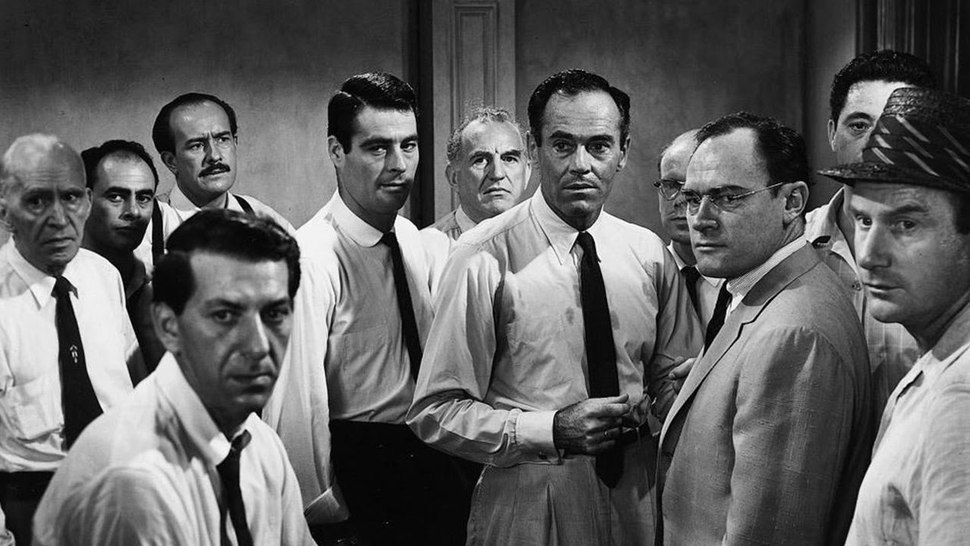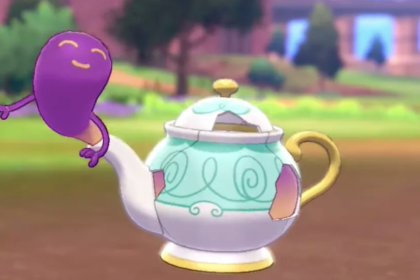12 Angry Men is a 1957 American courtroom drama movie adapted from a teleplay of the same name by Reginald Rose. The movie was written and co-produced by Rose himself and directed by Sidney Lumet. Take a look below for 26 more fun and interesting facts about 12 Angry Men.
1. Because the movie didn’t make a profit, Henry Fonda never received his deferred salary. Despite this setback, he always saw the movie as one of the three best he ever made. The others being The Grapes of Wrath and The Ox-Bow Incident.
2. At the beginning of 12 Angry Men, the cameras are all positioned above eye level and mounted with wide-angle lenses to give the appearance of greater distance between the subjects. As the movie progresses, the cameras slip down to eye level. By the end of the movie, nearly all of it is shot below eye level, in close-up and with telephoto lenses to increase the encroaching sense of claustrophobia.
3. Director Sidney Lumet had the actors all stay in the same room for several hours on end and do their lines over and over without filming them. This was done to give them a real taste of what it would be like to be cooped up in a room with the same people.
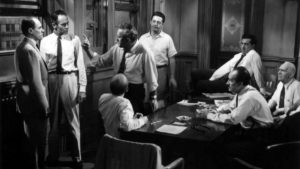
4. 12 Angry Men is commonly used in business schools and workshops to illustrate team dynamics and conflict resolution techniques.
5. Because of the painstaking rehearsals for the movie lasted two weeks, filming had to be done in an unprecedented 21 days.
6. With the death of Jack Klugman on December 24, 2012, none of the 12 jurors from the movie are alive today.
7. Henry Fonda, who symbolically wears white throughout the movie, personally asked Sidney Lumet to direct the movie adaption, having been impressed with his work on the television shows Studio One in Hollywood and The Alcoa Hour.
8. Reginald Rose’s television play script was left virtually intact in its move to feature film.
9. Henry Fonda was asked by United Artists to make 12 Angry Men, so he did it as both actor and producer. He was, however, very frustrated at being a producer and decided never to do it again.
10. After a short but rigorous rehearsal schedule, 12 Angry Men was shot in less than 3 weeks for a budget of just $350,000.
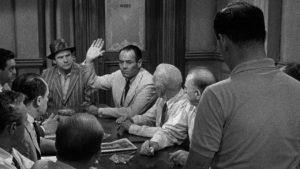
11. All but 3 minutes of the movie was shot inside the bare and confining, 16 by 24 foot jury room.
12. 12 Angry Men was shot in a total of 365 separate takes.
13. Many of the shots of the actors were filmed on their own, and then edited together. This required the sound of the rain to be recorded separately for each other.
14. In June 2008, 12 Angry Men was ranked number 2 on the American Film Institute’s list of the ten greatest films in the Courtroom Drama genre.
15. Because of the demands of the movie’s low budget, if the lighting was set up for a shot that took place from one particular angle, all the shots from that same angle had to be filmed then and there. This meant that different sides of the same conversation were sometimes shot several weeks apart.
16. 12 Angry Men was nominated for three Oscars, but the movie lost out in all categories to The Bridge on the River Kwai.
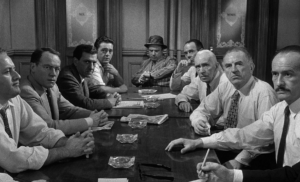
17. 12 Angry Men was the theatrical directorial debut of Sidney Lumet.
18. The “unusual-looking knife” in 12 Angry Men is an Italian stiletto switchblade with a Filipino-style Kriss blade.
19. Juror #7 claims that he made $27,000 selling marmalade. In 2018, that amount would be well over $250,000.
20. According to his autobiography, Henry Fonda was disappointed with United Artists’ distribution strategy, and felt that the studio’s approach had deprived the movie of a chance at financial success.
21. There are no female characters in 12 Angry Men, aside from the extras seen in the courtroom in the prologue, although a woman’s bathroom can be seen in the jury room.
22. Juror #7 looks at his watch a total of 28 times.
23. Henry Fonda and Reginald Rose deferred their salaries for the movie.
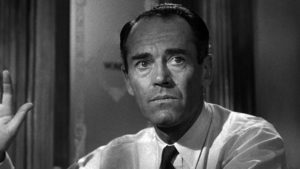
24. Juror #4 is the only juror who doesn’t take off his jacket at any point in the movie.
25. The entire movie takes place in just three rooms.
26. Indian singer Vennu Mallesh wrote a song called “12 Angry Men,” which pays homage to the movie and outlines the initial and final verdicts of the 12 jurors.

